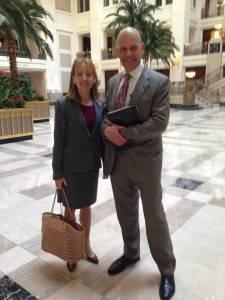By Alison Singer
President, Autism Science Foundation

This morning Stuart Spielman of Autism Speaks and I met with key leaders at the American Academy of Pediatrics and representatives from over 20 children’s health advocacy groups to talk about strategies for preventing wandering. A study sponsored by the Autism Science Foundation and a consortium of autism advocacy groups, and published in the journal Pediatrics, showed that 49% of children with autism attempted to wander at least once after age 4, which is four times the rate of unaffected siblings. 53 percent of those who eloped were missing long enough to cause concern. From age 8-11, 27 percent of children with ASD wandered, compared to only 1 percent of unaffected siblings.
In 2012, 25 children with autism died as a result of wandering. By way of comparison, 35 children in the U.S. died of flu and 19 died of whooping cough in 2012. The AAP supports massive campaigns to prevent those deadly diseases, as it should. Our goal today was to encourage the AAP to increase the resources devoted to implementing and supporting wandering prevention measures as well.
Our efforts around wandering involve both prevention and recovery. Of course we want to prevent as many wandering incidents as possible from happening, so today we talked with AAP members about including information about wandering in what the AAP calls “anticipatory guidance,” which refers to the conversations doctors routinely have with parents at well-child visits to let them know what’s ahead for their children. Only 14 percent of parents of children with autism reported that they were warned about the potential for wandering by their pediatrician (Pediatrics). We have to do better. Parents who are aware of the potential for wandering can take precautions to ensure the environment is as safe as possible. We also talked about providing more training and awareness materials to pediatricians so that they can share the information with their families.
On the recovery side, the group talked about working together to develop a “wandering alert” mechanism, similar to an AMBER alert, for children with developmental disabilities, addressing the unique needs of this population, including the propensity to head toward water and the fact that our kids might not respond when called by first responders or other searchers. When children with autism wander, families can’t access the AMBER alert system because technically the children are not abducted.
Wandering is an issue of life and death. The data, and the newspapers, show that children with autism continue to die from wandering related incidents. We are committed to doing all we can to reduce wandering and to protect as many children with ASD from wandering-related tragedies as possible.
Source:
Occurrence and Family Impact of Elopement in Children With Autism Spectrum Disorder
Connie Anderson, J. Kiely Law, Amy Daniels, Catherine Rice, David S. Mandell, Louis Hagopian, and Paul A. Law
Pediatrics peds.2012-0762; published ahead of print October 8, 2012,doi:10.1542/peds.2012-0762
